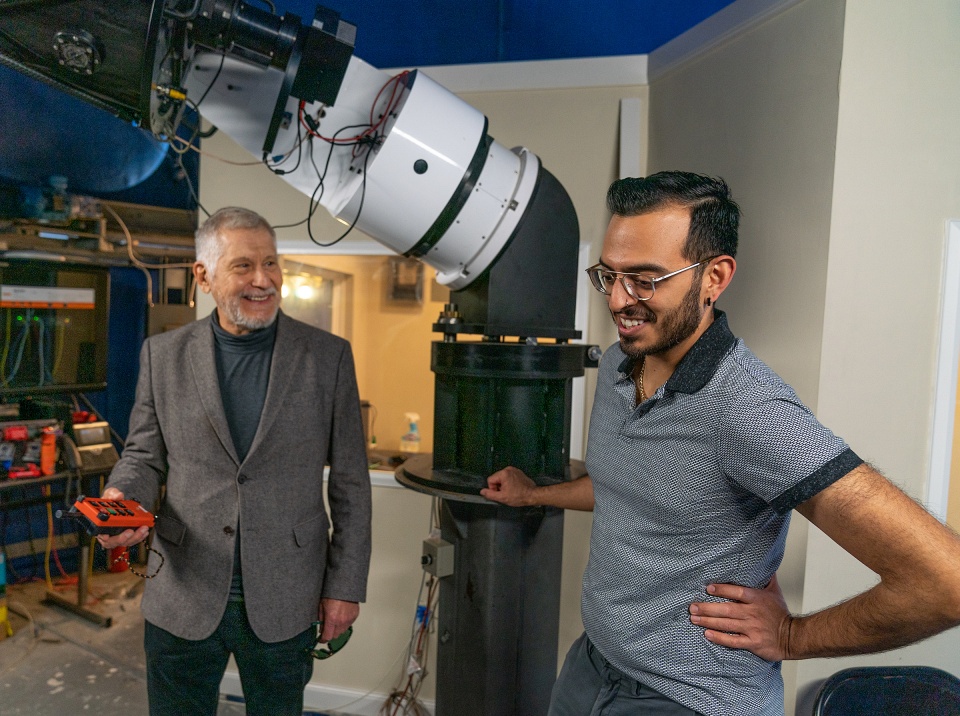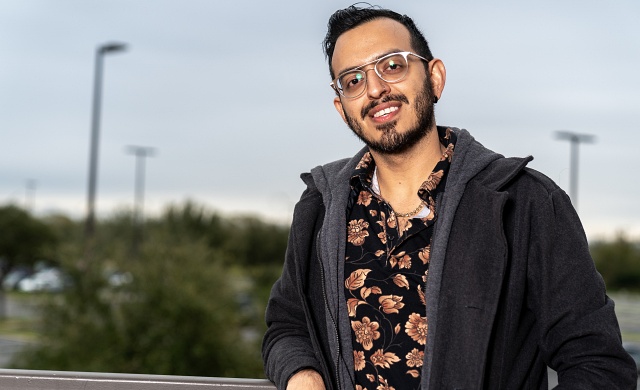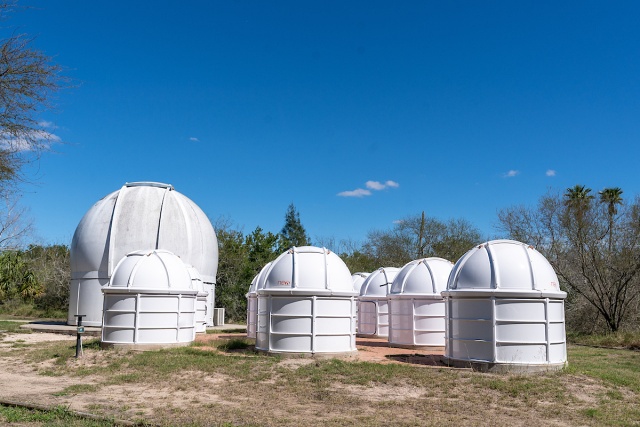By Letty Fernandez
RIO GRANDE VALLEY, TEXAS – Eight UTRGV students are making history as the first to be accepted to the new Ph.D. program in physics at UTRGV.
Moises Castillo, a Los Fresnos native and UT-Brownsville alumnus, has been with the university’s Physics program since he stepped onto the Brownsville Campus almost 14 years ago. Now a part-time lecturer in the astronomy and general physics labs at UTRGV, he said he is honored to be in the inaugural Physics cohort.
“We are establishing the foundation,” he said. “I want to be an example to others, and I believe my success in the program will pave the way for those who come after me.”
Castillo’s interest in science, physics and astronomy started when he was very young. He loved watching documentaries about space, and stargazing with his friends. When he was in high school, he often could be found at the public library. That’s where he came across an article about the Physics and Astronomy Department at legacy institution UTB/TSC.
“I remember seeing a graphic of a blackhole merger simulation and an article with credits to the legacy institution. Once I joined the department as a student, I realized that we really had a gem in science here in the Valley,” Castillo said.
Not surprisingly, he was in the very first Math and Science Academy at UTB/TSC in 2009, and earned his bachelor’s degree in Physics from UTB/TSC in 2012.
In 2019, he earned a master’s in Physics from UTRGV, and had been waiting patiently for the doctoral program in Physics to be approved.
“I knew we had the makings of a Physics PhD program, given the caliber of our professors and the work they do in all fields of study in physics,” he said. “Getting into the doctorate program is something I had been looking forward to for many years.”
DEEP ROOTS
Dr. Mario Diaz, director of UTRGV’s Center for Gravitational Wave Astronomy, joined the faculty at legacy institution UTB/TSC in 1996 and has many years invested in bringing a PhD in Physics to UTRGV.
“This doctoral program is huge for me,” he said. “It’s been a long road – 25 years of my life.”
Working together with the late physics professor Terry Jay Phillips, they began the work to expand the physics program.
“We always believed the development of a strong research component in the educational programs serving the Rio Grande Valley was crucial to promote the economic and social development of the region,” Diaz said. “We envisioned the physics program as part of this mission, so for many years we sought to develop a PhD program.”
Fast forward to 2015 with the establishment of UTRGV and the unification of academic faculties from legacy institutions UTB and UT Pan American.
The new-found enrollment strength brought about by the combining of the two UT System universities in the Valley helped make a compelling case for the new doctoral program in Physics, Diaz said.
After approval by The UT System Board of Regents and the Texas Higher Education Coordinating Board, the doctorate degree in physics was approved by the Southern Association of Colleges and Schools in November 2021.
Diaz is a member of the physics graduate committee, which is chaired by Dr. Efrain Ferrer. Both interviewed and selected the students admitted for the inaugural class. Besides the eight accepted for Spring 2022, they will add nine more students for the Fall 2021 semester.
“Most of the accepted students who are inaugurating this doctoral program finished their master’s in physics at UTRGV,” Ferrer said. “Some of them were eagerly waiting for the program to start, so they could continue their research training under the mentorship of their faculty advisors while advancing toward an even higher degree.”
Of the eight students admitted to the program, six are Latino and five are from the Valley.
Diaz said those demographics show the potential of the UTRGV Physics program to improve the underrepresentation of Latinos at the doctoral level.
Graduate students like Castillo want to improve those statistics not only by sharing their passion for science, but also by spreading the word about the opportunities that are here now, close to home.
“I hope to be able to spark the interest in science of our students,” Castillo said. “I want to be someone they can relate to – someone who grew up in the Valley and was able to get a PhD in Physics without the need to leave the Valley to do amazing work.”
For more information about the program, contact Ferrer at efrain.ferrer@utrgv.edu.
ABOUT UTRGV
The University of Texas Rio Grande Valley (UTRGV) was created by the Texas Legislature in 2013 as the first major public university of the 21st century in Texas. This transformative initiative provided the opportunity to expand educational opportunities in the Rio Grande Valley, including a new School of Medicine and a School of Podiatry, and made it possible for residents of the region to benefit from the Permanent University Fund – a public endowment contributing support to the University of Texas System and other institutions.
UTRGV has campuses and off-campus research and teaching sites throughout the Rio Grande Valley including Brownsville (formerly The University of Texas at Brownsville campus), Edinburg (formerly The University of Texas-Pan American campus), Harlingen, Weslaco, McAllen, Port Isabel, Rio Grande City and South Padre Island. UTRGV, a comprehensive academic institution, enrolled its first class in the fall of 2015; the School of Medicine welcomed its first class in the summer of 2016, and the School of Podiatric Medicine in the fall of 2022.



